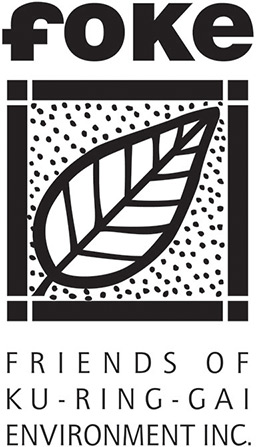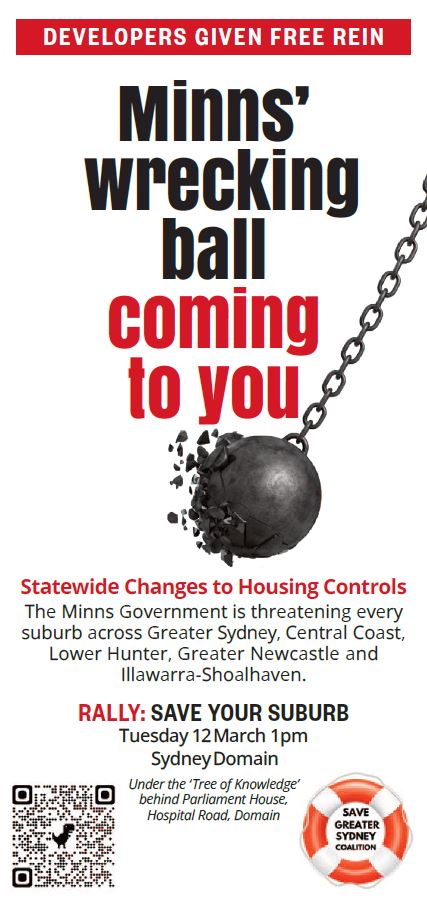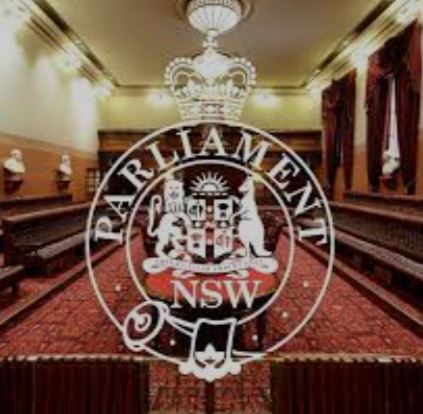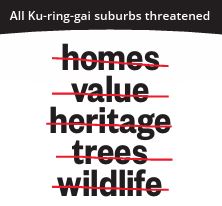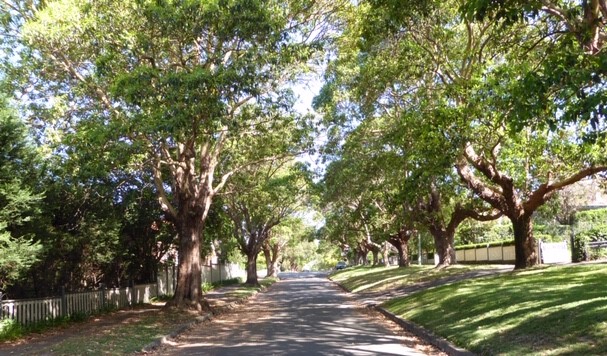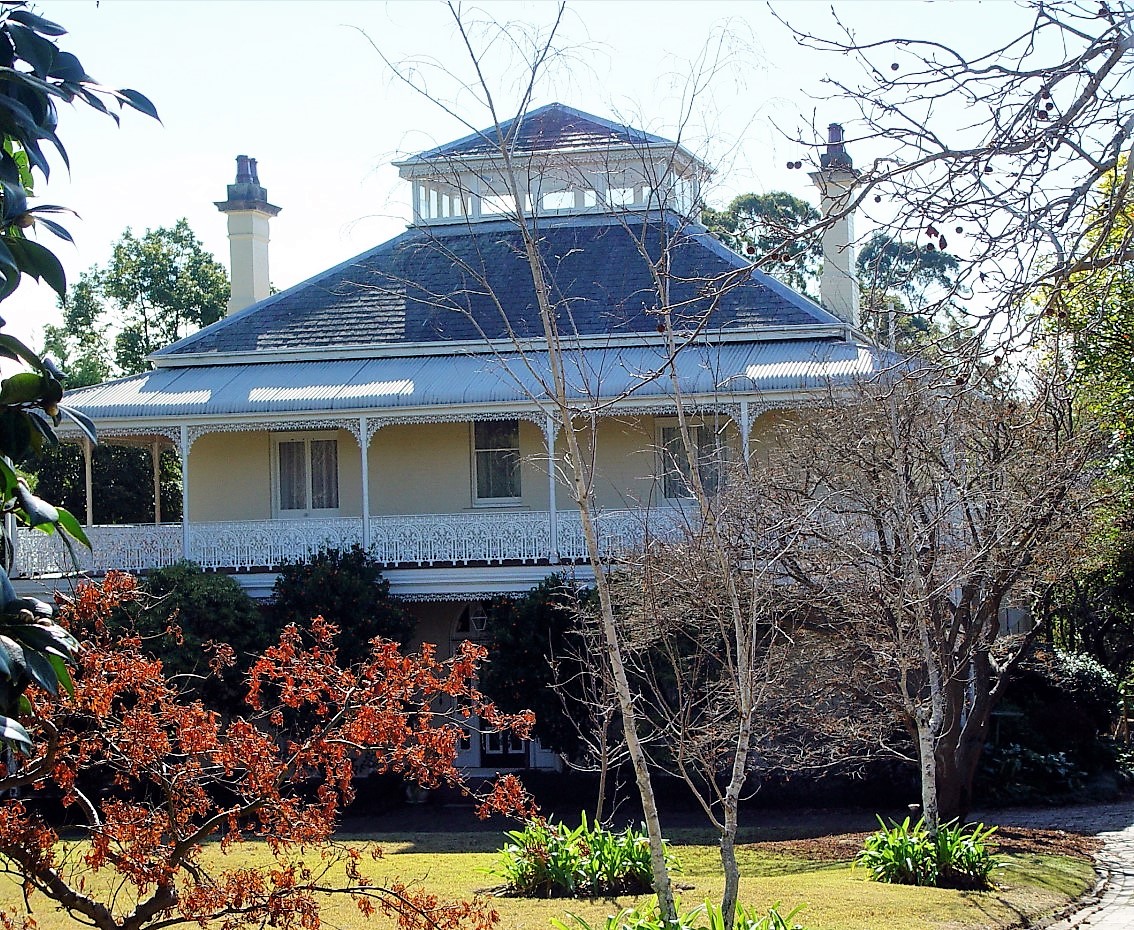Please write letters to the Upper House Crossbench calling on them to SUPPORT The Hon. Scott Farlow, MLC & Shadow Minister for Planning’s DISALLOWANCE BILL opposing the Transport Oriented Development (TOD) program across Greater Sydney, including in Ku-ring-gai.
Continue readingSydney’s ‘land banking’ crisis
Read Greg Callaghan’s article ‘Left to rot: The ‘ghost homes’ scourge in our big cities – amid a housing crisis, Sydney Morning Herald, 13 July 2024
Continue readingFOKE E-News July 24
Find out how you can help protect Ku-ring-gai – a place of outstanding heritage & environmental significance.
Continue readingVale Don Brew
FOKE member Don Brew (1935 – 2024) was honoured by Ku-ring-gai Council for his fearless and dedicated advocacy for Ku-ring-gai’s heritage.
Continue readingHope – Interim Heritage Order
Ku-ring-gai Council is working hard to protect Ku-ring-gai’s 23 Heritage Conservation Areas.
Continue readingIt’s YOUR home. YOU don’t have to sell
The Transport Oriented Development and Well-Located Housing SEPPs have triggered a surge of interest among developers, leading to a frenzy of activity akin to a gold rush. Developers are increasingly reaching out to homeowners with offers to secure “Option Contracts” for the future purchase of their land.
Continue readingAttend, listen & watch TOD Inquiry on Wed 24 July
The final public hearing on the Development of the Transport Orientated Development (TOD) will be held in the Macquarie Room, Parliament House, Sydney on Wed 24 July, 2024
Continue readingFOKE Talk, July 2024
Read FOKE’s newsletter ‘FOKE Talk’, July 2024 to find out the latest issues facing Ku-ring-gai.
Continue readingFOKE’s President Report, 22 May 2024
Read Kathy Cowley, FOKE President’s Report that tells the work that FOKE has done to protect Ku-ring-gai over the past year.
Continue readingDespair – Low- & Mid-rise Housing & Dual Occupancies
Thanks to all who attended Ku-ring-gai Council’s community forums on the NSW Government’s Low and Mid-Rise Housing plans.
Continue readingVolunteers needed Sun 14 July
Help FOKE save our trees and wildlife. Volunteers needed on Sunday 14 July
Continue readingSave Greater Sydney Coalition Forum on 7 August
Please join FOKE on this important forum in the NSW Parliament Theatrette on Wednesday 7 August 2024 at 6,30pm. Booking details to follow soon.
Continue readingYES it IS BAD for the whole of NSW
Read why FOKE agrees that the NSW’s Government’s housing policy is “bad for the whole of NSW”.
Continue readingLow & Mid-Rise Threats
Watch Ku-ring-gai Council explain the planning disaster that is coming to every street that is 800 metres from a train station or large supermarket
Continue readingDisallow and STOP the TODs
says Scott Farlow, MLC & Shadow Minister for Planning
Continue readingFOKE’s evidence against TOD
Read FOKE’s evidence against the TOD
Continue readingMinns forgets his “avalanche of many ugly, poorly built developments” speech
FOKE wishes to remind Premier Chris Minns what he said on the floor of the Legislative Assembly on 8 August 2018 about planning for Greater Sydney.

Read the full speech on Hansard
Read Premier Minns and his TOD SEPP by:
Paul Scully, MP, Minister for Planning & Public Spaces State Environmental Planning Policy (Housing) Amendment (Transport Oriented Development) 2024 under the Environmental and Planning Act 1979 HERE
18 June, 2024
TOD Disallowance Bill
Read more about the TOD Disallowance Bill HERE
Scott Farlow, MLC & Shadow Minister for Planning, has introduced a Private members Bill into the Legislative Council. This Bill is the Environmental Planning and Assessment Act 1979 to enable State Environmental Planning Policy (Housing) Amendment (Transport Oriented Development) 2024. The aim is to disallow the Transport Oriented Development (TOD) program that is a blunt and one-size-fits all instruments that will have catastrophic impacts on Ku-ring-gai s tree canopy, environment, heritage and amenity.
On 5th June 2024, Scott Farlow said:
“The Coalition supports measures, including increasing density along transport corridors, to meet ambitious housing targets, but they must be done right and in consultation with local communities. This has not been the case with the Transport Oriented Development State Environmental Planning Policy, which provided no opportunity for community consultation despite increased community participation being an object of the Act”.
Read FULL STATEMENT HERE
The Bill will be introduced into the Legislative Council.
Please urge MLCs to vote for the TOD Disallowance Bill.
Please ADAPT and EDIT in your own words the letter below:
Then send the email to each member of the crossbench asking them to support the Disallowance Bill.
Their contact emails are HERE
Read TOD SEPP by:
Paul Scully, MP, Minister for Planning & Public Spaces State Environmental Planning Policy (Housing) Amendment (Transport Oriented Development) 2024 under the Environmental and Planning Act 1979 HERE
18 June, 2024
Ku-ring-gai remains steadfast on TOD legal action
FOKE thanks Ku-ring-gai Councillors who voted to continue the legal action against the NSW Governments undemocratic and environmentally and heritage destructive Transport Oriented Development (TOD) program.
A majority of nine councillors stood steadfast in their support to continue the legal action against the TOD.
Watch Ku-ring-gai Council meeting HERE.
Since coming into effect on 13 May, 2024, the TOD continues to cause anguish, distress and despair for residents and particularly to those living within 400 metres of Gordon, Killara, Lindfield and Roseville Stations.
The TOD will allow 6 to 7 storey apartment buildings on most sites within 400 metres of Gordon, Killara, Lindfield and Roseville railway stations.
Residents remain in shock to think that a NSW Government would allow Ku-ring-gai’s unique and irreplaceable heritage and environment to be so willfully destroyed by developers.
Many residents are now being threatened with financial and housing insecurity. Those living within the TOD are being pressured to sell their properties with threats that if they don’t their properties will be devalued.
Ku-ring-gai Councillors know they have no choice but to take legal action. The NSW Government has shown no indication that they will negotiate with Council. Instead, Minns appears determined to push through this undemocratic TOD hyper-overdevelopment SEPP that will be catastrophic for not only Ku-ring-gais heritage and environment but NSWs.
It is pleasing to hear that the NSW Liberals are prepared to overturn the TOD program.
We now have hope that Councils legal challenge and the Coalitions Disallowance Bill will stop the disastrous TOD.
Postscript
Read TOD SEPP by:
Paul Scully, MP, Minister for Planning & Public Spaces State Environmental Planning Policy (Housing) Amendment (Transport Oriented Development) 2024 under the Environmental and Planning Act 1979 HERE
11 June, 2024
Stop Crs Spencer & Pettett selling out Ku-ring-gai
Attend Ku-ring-gai Council meeting
Tuesday 4 June, 2024 7pm
Council Chambers 818 Pacific Highway, Gordon (entrance at rear of Council)
Send the message to all Ku-ring-gai Councillors: STAND UP FOR KU-RING-GAI
Email: councillors@krg.nsw.gov.au
Read Crs Spencer & Pettetts Notice of Motion HERE
Cr Cedric Spencer & Cr Jeff Pettett have called for an Extraordinary General Meeting on Tues 4th June 2024 at 7pm to rescind Ku-ring-gai Councils legal action against the NSW Government’s undemocratic, unaffordable and unsustainable rezonings – known as the Transport Oriented Development (TOD) program.
Their actions are irresponsible and go against resolutions councillors have consistently voted for since November 2023.
Legal action is the only power Ku-ring-gai Council has to save ratepayers millions of dollars in infrastructure costs that will come with the rezoning for high density housing in Roseville, Lindfield, Killara and Gordon.
Already developers have announced they want the TOD program to be extended to other areas. This rings alarm bells for more high density rezonings for Pymble, Turramurra, Warrawee and Wahroonga. This means more environmental and heritage destruction for Ku-ring-gai—wiping out its tree canopy and heritage conservation areas.
Cr Spencer & Cr Pettett’s motion signals a “green light” for developers to make super profits from what is the largest rezoning ever in the history of Ku-ring-gai and Greater Sydney.
If passed their actions could destroy Ku-ring-gai’s tree canopy, heritage and lead to planning chaos with no additional infrastructure.
FOKE’s evidence to TOD Inquiry
FOKE was invited to give evidence to the NSW Parliament’s Upper House Inquiry into the development of the Transport Oriented Development Program (TOD) on Monday 20 May 2024 in the Macquarie Room, Parliament House, Sydney.
FOKE concluded its evidence calling on the NSW Government to immediately withdraw the TOD program because of the devastation it will cause not only to the natural, built and cultural heritage of Ku-ring-gai but for Greater Sydney.
During FOKEs session from 12.15 pm, Mr Frank Howarth AM (Chair, Heritage Council of NSW); Mr David Burden (Conservation Director, National Trust of Australia (NSW) and Ms Jozefa Sobski AM (Vice President, Haberfield Association Inc) presented evidence as well.
Following FOKE’s presentation the Save Greater Sydney Coalition (SGSC) which FOKE is a member of, presented their evidence. It was a powerful presentation!
Read list of speakers at Upper House TOD Inquiry 20.5.24 HERE
Watch video of FOKE’s evidence to the Upper House TOD Inquiry Hearing 20.5.24 HERE
Read transcript of FOKE’s evidence to the Upper House TOD Inquiry Hearing 20.5.24 HERE
Read FOKEs Submission to the TOD Inquiry 27.3.24 HERE
Read further information about the Upper House Inquiry HERE
Postscript
Read TOD SEPP by:
Paul Scully, MP, Minister for Planning & Public Spaces State Environmental Planning Policy (Housing) Amendment (Transport Oriented Development) 2024 under the Environmental and Planning Act 1979 HERE
Ku-ring-gai’s WAKE UP letter to NSW residents
READ Ku-ring-gai’s open letter to NSW residents, published in early May 2024:
An open letter to NSW residents – WAKE UP
We’ve all heard about the NSW Government’s plans for increased housing. But no-one has heard anything about how our schools, hospitals, roads and parks are meant to support this population growth.
Read full letter HERE
Save Sydney Rally
ON Tuesday 12 March 2024 1pm
AT Tree of Knowledge behind Parliament House, Hospital Road, Domain. Map here.
PROTEST against the new planning laws proposed by the NSW Government.
THREATENS every suburb across Greater Sydney, Blue Mountains, Central Coast, Lower Hunter, Greater Newcastle and Illawarra-Shoalhaven.
BRIING banners identifying your suburb or council area.
SPEAKERS will include MPs, Mayors & Community representatives.
SHARE with your networks, community groups, neighbours, friends and family.
VISIT SAVE GREATER SYDNEY COALITION Website & Facebook
CONTACT KATHY COWLEY, President, FOKE, info@foke.org.au for more information
TOD Inquiry Announced
The NSW Parliament has announced an Upper House Inquiry into the Development of the Transport Orientated Development Program (TOD).
Submissions are due on 28 March 2924.
The TOD Program will devastate Ku-ring-gais heritage conservation areas and environmentally sensitive lands particularly the 400 metres surrounding Roseville, Lindfield, Killara and Gordon Stations.
Both the TOD Program and the Low and Mid-rise Housing State Environmental Planning Policy (SEPP) will include a “non-refusal” standard which will disallow Ku-ring-gai Council heritage and environmental controls.
The TODs 3:1 FSR and 6-7 + storey heights (with no minimum lot size or lot width) will effectively wipe out Heritage Conservation Areas and remove critically endangered Blue Gum High Forest (BGHF) and Sydney Turpentine Ironbark Forest (STIF) in Roseville, Lindfield, Killara and Gordon.
The Upper House Committee consist of:
Chair: Sue Higginson MLC (GREENS)
Deputy Chair: John Ruddick MLC (LDP)
Members:
Mark Buttigieg MLC (ALP)
Anthony D’Adam MLC (ALP)
Scott Farlow MLC (LIBERAL)
Jacqui Munro MLC (LIBERAL)
Peter Primrose MLC (ALP)
The Terms of Reference can be found here.
It is critical that as many submissions be sent in by members of the community.
Say NO to NSW Government
Send your submission HERE by deadline Friday 23 February, 2024
Ideas to help you send your submission:
The NSW Minns Government planning ‘reforms’:
- are grossly UNDEMOCRATIC.
- are flawed. They undermine the integrity of the entire NSW PLANNING system and will lead to planning chaos.
- will destroy the character, heritage and environment of Sydney’s diverse suburbs with a “one size fits all policy”.
- fails to consider local amenity impacts, including overshadowing, loss of privacy, loss of scenic views, loss of streetscape.
- fail to ensure good quality and good designed apartment buildings.
- put the interests of property developers before the COMMUNITY.
- will allow super windfall rezoning profits to be ‘gifted’ to property developers.
- will not address the housing affordability crisis.
- will open the NSW planning system to “corruption risk” with the introduction of the ‘non-refusal standards’ (including money-laundering).
- deny natural justice for those residents living within a Transport Oriented Development (TOD) with no opportunity to object.
- deny natural justice for those residents living across Sydney with the introduction of the Changes to create low and mid-rise housing occurring just before the Christmas, New Year and school holidays.
- lack transparency and accountability. The Minns Government refuses to release the “Cabinet in confidence“ evidence justifying why Roseville, Lindfield, Killara and Gordon had the necessary infrastructure to take further density. the TOD to be introduced 400 metres surrounding Roseville, Lindfield, Killara, Gordon Railway Stations can take the increase in density.
- are environmentally irresponsible when Sydney’s natural ENVIRONMENT is under severe with the escalating threats of climate and biodiversity extinction.
- fail to acknowledge Sydney’s environment interconnections. Ku-ring-gai is the lungs of Sydney. What happens to Ku-ring-gai’s trees will impact on Western Sydney’s, Northern Beaches, Sydney Harbour’s and the Hawkesbury River’s environmental health.
- will devastate Ku-ring-gai’s natural environment with the overriding of existing Council protections including Tree & Vegetation Development Control Plan (DCP), Urban Forest Policy, Threatened Species Community.
- Fail to acknowledge Ku-ring-gai as an environmentally sensitive area.
- Fail to acknowledge Ku-ring-gai’s Aboriginal heritage that is a local government area that has one of the most significant Aboriginal sites in Sydney.
- will push Ku-ring-gai’s Critically Endangered Ecological Communities (Blue Gum High Forest, Sydney Turpentine Ironbark and Duffys Forest) and its wildlife and birdlife to extinction (Federal Environment Protection and Biodiversity Conservation Act).
- will destroy Ku-ring-gai’s tree canopy. Already Ku-ring-gai’s tree canopy is under serious threat with an 8-9% slash in tree canopy cover. The NSW Housing Strategy will accelerate this destruction. It will destroy the vital wildlife corridor/national park railway line ridge.
- will have an adverse impact on Lane Cove National Park, Garigal National Park, Ku-ring-gai Chase National Park. As well the integrity of the remaining pockets of intact Blue Gum High Forest at the Dalrymple-Hay Nature Reserve (St Ives), Sheldon Forest (Turramurra) will be placed under pressure. Other bushland reserves include Ku-ring-gai Flying-Fox Reserve (within 400 metres of Gordon Railway Station), Granny Springs Reserve (Turramurra), Swain Garden, Seven Little Australians Park.
- ignores Ku-ring-gai’s geography. geology and climate. Ku-ring-gai suburbs are located on a thin ‘railway line’ ridge that climbs to about 200 metres and has the highest rainfall in Sydney. There are many creeks running from this ridge east and west, flowing down into either the Lane Cove, Garigal or Ku-ring-gai National Parks. The canopy trees, bushland reserves, gardens are environmentally critical to the survival of these national parks. The NSW housing policies will lead to more intensive hard surfaces. During high rainfall events this will lead to flash flooding, with pollutants, rubbish and weeds being flushed into the National Parks.
- will result in wildlife extinction. Ku-ring-gai has more native species than the entire United Kingdom. Ku-ring-gai is a hot bed of biological diversity that supports over 800 native plants, 170 fungi and 690 fauna species (including the threatened species – Grey-Headed Flying Fox and Powerful Owl.
- ignores the evidence that Ku-ring-gai is one of Sydney’s most ecologically sensitive places.
- Fail to provide an Environmental Impact Assessment (EIA) regarding the multiple rezonings since 2004 when the last major rezonings occurred as LEP 194.
- will demolish Ku-ring-gai’s hard won HERITAGE Conservation Areas that includes the nation’s best 20th Century domestic architecture.
- fail to acknowledge and respect the character, heritage and environment of a local area. They are blunt, one-size-fits all changes that will irreversibly destroy a community’s liveability, character, heritage and the environment.
- abrogate NSW’s obligations to protect individual heritage items (eg Eryldene) and Heritage Conservation Areas . If allowed it means that heritage protection will be extinguished across NSW.
- will destroy Ku-ring-gai’s heritage where the ‘natural dominates the built form’. Ku-ring-gai’s garden and bushland suburbs will be demolished and replaced with hard surface concrete.
- fails to recognise Ku-ring-gai’s significance to the Australia’s cultural, natural and environmental pioneer history. Ku-ring-gai is the birthplace of the modern Australian environment movement with environmental pioneers such as Annie Wyatt (founder of the National Trust of Australia), Charles Bean, Eccleston du Faur, Alex Colley, Paddy Pallin.
- will overwhelm existing ageing INFRASTRUCTRE for stormwater, sewerage and drinking water, train carrying capacity.
- fails to address the risks that Ku-ring-gai faces from climate fueled bushfires, wild storms and flash flooding.
- will cause continual traffic congestion chaos. Ku-ring-gai has limited access roads to the Pacific Highway. In an emergency how will the ambulance get to the hospital? Streets will be impassible with additional carparking.
- are silent on controls to ensure new multistorey developments have net zero emissions with roof top solar and community batteries for the high energy required for lifts and air conditioning.
- fail to provide the funds to purchase additional land for more parks, playgrounds, green spaces, sporting fields, swimming pools as well as services such as schools, hospitals, libraries and community and recreational facilities.
- fail to acknowledge that over the past 20+ years, Ku-ring-gai Council’s attempts to strengthen the protection of Ku-ring-gai’s heritage and the environment have been ignored, denied or delayed by the NSW Planning Department (eg 10/50 vegetation clearing rule). Concurrently environment, heritage and local government powers have been significantly weakened. It is time to strengthen urban environmental protections – not extinguish them.
What will the development being proposed within 400 metres of the stations look like? No setbacks. No trees. No conservation areas.
NSW Labor DETERMINED TO DESTROY KU-RING-GAI

“You have something special here in Ku-ring-gai. Fight for it.” – Tom Uren
Ku-ring-gai is about to be destroyed.
It is now time for residents to fight for Ku-ring-gai.
The NSW Government is planning to destroy Ku-ring-gai – its tree canopy, its heritage homes and its character.
IT IS IMPORTANT for residents to:
a) complete a Ku-ring-gai Council online survey about their say on the planning changes
b) send feedback to the State Government’s planning department here.
THE DEADLINE IS FRIDAY 23 FEBRUARY, 2024.
The NSW Government proposes dual occupancies in low density residential zones on block sizes of 450sqm. A block of 900 sqm will allow four homes to be built on it.
The NSW Government’s blanket zonings will allow terraces, townhouses, manor houses (two storey apartment blocks) and 6 to 7 storey mid-rise apartment blocks to be built within walking distance of railway stations. Possibly too for Ku-ring-gai’s local centres – East Killara, East Lindfield, West Gordon, West Pymble, West Lindfield, South Turramurra, North Turramurra?
Ku-ring-gai’s future will be dramatically different – traffic congestion, high rise with the removal of thousands of trees. Heat stress turbocharged. Wildlife extinguished. Heritage erased.
In April 2024 the NSW Government plans to implement ‘Transport Oriented Development’ (TOD).
TOD allows blanket 6 to 7 storey unit developments within 400m of the Roseville, Lindfield, Killara and Gordon railway stations. Eight to nine storeys will be allowed if developers provide “affordable housing”.
Heritage Conservation Areas WILL NOT BE PROTECTED.
The NSW Government has indicated it will NOT CONSULT Ku-ring-gai residents over its TOD high rise rezoning changes.
For more information see Ku-ring-gai Council: ‘Proposed changes to NSW housing policy and its impacts on Ku-ring-gai’.
NSW Government announces intentions for MORE HOUSING DENSITY
At the last Ku-ring-gai Council meeting, less than two weeks before Christmas 2023, Mayor Ngai tabled a Mayoral Minute : “The Trickle of Information Regarding Housing Density Changes – Tuesday 12 December 2023”about the State Government’s intentions for more housing density for Ku-ring-gai.
Below is FOKE’s summary of the Mayoral Minute. The full Mayoral Minute can be read here.
The State Government intends to legislate two State Environmental Planning Policies (SEPPs) to override Ku-ring-gai Council planning controls.
1. SEPP relating to “diverse and well-located homes”
The NSW Government has announced it intends to legislate new planning controls to allow terraces and townhouses from being built in R2 Low Density Residential zones and residential flat buildings (apartments) to being built in R3 Medium Density Residential zones.
This would shift the goalposts with unintended consequences on infrastructure, planning, and biodiversity.
It is understood that if this “diverse and well-located homes” SEPP is legislated by the NSW Government it will:
• increase housing density within 800m walking distance to a well-located area’, ie close to existing train stations and town centre precincts (it remains unclear as to whether local neighbourhood centres will be includes)
• Multi-dwelling houses to be allowed in R2 zones within 800m walking distance of well located areas
• 6 storey apartments to be allowed in R3 zones within 400m walking distance of well located areas
• 3 storey apartments to be allowed in R3 zones within 800m walking distance of well located areas and
• Dual occupancies to be allowed anywhere else in NSW zoned R2.
A letter sent to Ku-ring-gai Council from the Department of Planning on 16th July 2021, indicates it wants Council to implement ‘medium density’ (then townhouses) in Roseville, Roseville Chase, Killara, Pymble, Wahroonga, West Gordon and North St Ives.
2. SEPP relating to “transport oriented development”
• The SEPP intends to allow 6 storey apartments on any zoned land within 400m of each train station, although it has not been confirmed whether this is 400m walking distance or 400m radius
• The planning controls will allow building heights of 6 storeys (21m) with a floor space ratio of 3:1
• New parking rates will apply
• No minimum lot size or lot width rules will apply and developments in commercial areas must make sure street frontages are activated
• The State Government does not believe further support for infrastructure is necessary
• The SEPP will apply to Heritage Conservation Areas, although details on this remains unknown
• The SEPP will designate each area as “special entertainment precincts” with venues trading later and exempt from normal rules about amplified music.
Ku-ring-gai Council has responded with concerns about:
• The lack of consideration for infrastructure (transport, stormwater, education and recreation)
• The significant loss of tree-canopy, which is vital to protecting biodiversity as well as to support climate-change resilience
• The potential impacts to the character of Sydney, including impacts to our Heritage Conservation Areas
• The lack of detail publicly available on either SEPP
• The perceived rush to implement each SEPP
• The perceived lack of public consultation regarding the above.
The situation is compounded by the State Government’s withdrawal of $9.8m funding for the Lindfield Village Hub commuter carpark, which has put the project in jeopardy, delayed the delivery of housing, and sabotaged the good faith efforts of both Council and the potential developer.
Recommendation:
A. That Council notes this Mayoral Minute, awaits the release of detail on each SEPP, and continues to voice its concerns both individually and in co-operation with other local councils and industry bodies such as LGNSW and NSROC.
B. That as soon as practicable after the public release of detailed information on each SEPP, Council will inform the residents of the impacts of proposed changes as well as any public feedback or consultation mechanisms available to them. Council will also respond as necessary to protect the interests of current and future residents of Sydney.
Heritage Act Reforms
In May 2021, the NSW Government announced a major review of the Heritage Act, 1977 which would contribute to its legislative reform.
The NSW Heritage Act is the single most important instrument in our state that identifies, protects and conserves our heritage and we believe should only be strengthened.
FOKE participated in a National Trust Forum on the Government’s Discussion Paper on the 9th May with 277 experts, heritage organisations and other participants.
We believe the current Heritage Act is very robust and working well and needs only minor updating.
The stated intention of the review is to make heritage ownership easier, more affordable and maximising a heritage item’s economic value.
Our main concern is that the discussion paper intends to water down the current Heritage Act’s conservation and protection measures. Under the rationale for the review, the prescriptive controls which have helped conserve and protect heritage items are cited as outdated, with no real comment as to best practice improvements or any strengthening of the Act.
Rather the paper recommends a ‘nuanced’ approach to heritage controls, which will only lead to individual interpretations resulting in legal battles among residents, developers and local and state planning controls. Prescriptive controls have proven to be successful in other countries such as the UK.
The key areas supported in our submission relate to the need to address Aboriginal Heritage, the ability to issue penalty infringement notices for non-compliance or wilful deterioration of a heritage item, and financial incentives for funding conservation.
The issues raised that are not supported are streamlining the delisting process, and extending the levels of heritage protection into four categories.
However, the Act would benefit by excluding heritage from State Significant Developments, which currently can override the provisions of the Heritage Act. As we have just seen with the removal of Willow Grove to make way for the Parramatta Powerhouse museum.
Similarly, Heritage items should have a significant conserved perimeter where no development is allowed. Most heritage is an item in a setting that adds to its value and historic validity, hence the area surrounding it needs to be similarly protected.
Why are only 4% of the 40,000 State Heritage Inventory Items actually listed on the Heritage Register?
The Heritage Council is adding fewer and fewer items each year. Without protection these items will be lost. The National Trust (NSW) have listed over 100 buildings and places that in their view warrant State Heritage listing which the Heritage Office has not registered.
Heritage assessment and relevance to local, state or national significance should be maintained. Any proposed amendments should result in better heritage outcomes rather than a weakening of heritage protections.
